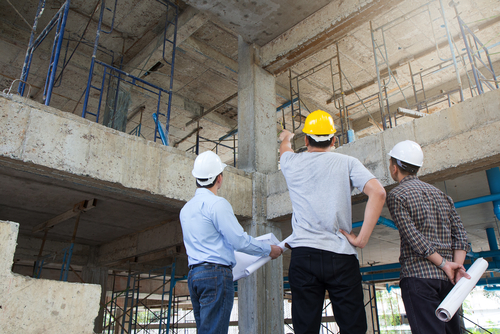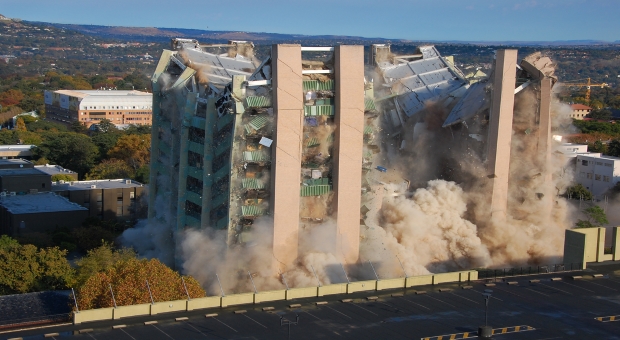Of all the types of disasters we face, natural disasters are the most likely to occur…
Mankind has been plagued with natural disasters since the beginning of time and I’m sure we will continue to suffer them as long as we inhabit this earth.
Even so, the ways we suffer natural disasters today is somewhat different than the ways our ancestors did. Our technology allows us to build structures which can much more easily withstand the ravages of nature, helping us to survive. But at the same time, when those structures can’t withstand the forces of nature, they cause even more damage, when they come down, than nature alone can inflict.
Take the many highway overpasses that fell during the San Francisco earthquake of 1989. If that overpass hadn’t been there, those people would have survived. That’s just one example. Almost every major earthquake and major hurricane provides us with additional examples.
The crane falling in Dallas on June the 9th is another such example. As is common in large cities, that tower crane was installed for the construction of a large building; in this case, with an attached parking garage. Tower cranes are popular in such applications, due to their small footprint. Rarely do they have any serious problems with such cranes falling, as they are fixed to the foundation or the building under construction, rather than sitting on a truck chassis.
But this was the exception to the rule, as high winds buffeted the crane, apparently causing the tower to collapse; a very unusual accident.
How could such an accident happen? If you look at the video of the event, the crane was high above the construction being conducted. Typically, these tower cranes reach only a few stories above the current level of construction. But since this one was so high, there was more leverage for the wind to use, when pushing against the crane. Apparently, there were 70mph winds that day.
I’m guessing here (as an engineer), but even with the open design of the crane’s trusses, there was a lot of force against the side of the crane, especially if the winds were blowing in such a way that the crane was at a 90 degree angle to them. In that case, the combination of high wind and a high tower would cause the crane to start swaying. Such action is hard on the metal structure of the crane and eventually a weak point was found, with the strain of the swaying focusing on that weak point.
If you look at the pictures of the downed crane, you’ll see it bent over at a 90 degree angle, about three stories above the ground. That’s where the crane’s tower bent and broke, as the swaying worked that metal back and forth to the point of breaking that massive structure.
These types of cranes are extremely heavy, as witnessed by the fact that the top of the crane broke through three floors of the building across the street. That’s breaking through three reinforced concrete floors. Part of that weight is the structure of the crane itself while the other part is the huge counterweight that is attached to the back end of the crane arm, helping it to keep balance when picking up heavy loads.
What can we learn from this?
Okay, enough analysis of what happened; what can we learn from this situation?
First of all, we must realize that anything man can make, nature can destroy. This lesson seems to keep cropping up, over and over again. Yet it also seems to be forgotten just about as often as it comes up. Somehow, in our arrogance, we think that we can build structures that can withstand nature. While that might be true to a point, there are limitations.
Every man-made structure is designed and built with to withstand a certain amount of force. We saw this during Hurricane Katrina, as a number of refineries failed to withstand the high winds of that category 5 hurricane.
Countless people asked why those refineries hadn’t been built to withstand the hurricane. But they had. At least, they had been built to withstand lesser hurricanes. However, someone decided that the risk of a category 5 hurricane was low enough, that they didn’t need to design and build for it. Therefore, the refineries failed when the winds surpasses their design limitations.

We must all realize that these structures, along with others, are not perfect; nothing made by man is. That needs to be taken into consideration when we do our risk assessments. In addition to the things Mother Nature can throw at us, what can she throw at man-made structures around us and how will that affect us.
Granted, this is a one-of-a-kind accident, which may never be repeated. That’s not the point though. As preppers, if there’s even a possibility of it, or anything like it, being repeated, we should be aware of it and what it might do to us. After all, how can we evaluate the potential impact of something, if we are unaware of it?
What can we do?
There is little any of us can do to stop accidents involving major structures. Not only do we not own the structures themselves, but we often depend on them, especially if they are part of our city’s infrastructure. On top of that, the average person doesn’t have enough technical knowledge to evaluate the safety of these structures, warning of potential failure.
Nevertheless, we can all see. Considering that many structural failures are predicated by some sort of visual indication, there is a chance that any of us could see damage to one of these structures (rust, cracks or chipped concrete), which might indicate a potential for failure. Bringing that damage to someone’s attention may not get any action; but then again, it might.
The other thing we can always do is to move away from the potential danger, if we are concerned about it. Granted, there is nowhere in the world that we can move to, which doesn’t have some degree of potential danger, but there’s no reason to take our chances. Something that seems to be a potential risk, for which you can’t get an adequate answer, seems to me to be a good enough reason to move, especially when we’re talking about large structures with the potential for massive damage.
That’s not going to stop a potential failure from happening, nor is it going to rescue someone who is trapped by such an event; but it will keep us from being the ones who need rescue. Sometimes, that’s the best we can hope for.
There’s something else we should do
But there’s something else. I believe we should all concern ourselves with rescue as well. Granted, this isn’t something that most preppers talk about; but perhaps we should.
Being prepared for our own families is important. But where is it written that we should only be concerned about our own? If our family is safe, shouldn’t we be the ones to be concerned about others as well?
In most cases, rescue operations are going to require much more than the ability we have. Looking at the pictures of the building the crane fell into, I can’t see any way that the average person could break up that crane to move it or break up the cement slabs that are broken. Those types of things are beyond our capabilities.
On the other hand, someone needs to go in there and make sure that the people living in those apartments have gotten out and that the cars in the parking garage were empty. Yes, we could leave that to “the professionals,” but why? If your family was there and in need, would you want people standing around, waiting for the fire department to show up?
The other thing we can do is be prepared to render first-aid. That’s something we all should learn anyway as part of our own prepping activities. Medical facilities and personnel tend to get overloaded in any disaster situation. So learning first-aid and having a good trauma kit on hand is an important part of taking care of our own families. In a disaster, the first-aid that we are able to give may very well be what keeps a family member alive.
So then, if we have learned or we are going to learn first-aid anyway, doesn’t it make sense to use those skills to take care of the injured, while waiting for the professionals to get there?
This accident actually had very few casualties, considering how grave it was. But that’s not saying that the next one will be the same. It could just as likely have hundreds. In a case like that, there aren’t enough trained professionals in all the fire trucks and all the ambulances to render first aid. Many people will end up not receiving aid, for no other reason than there not being enough trained people to get to them all.
If you and I throw our weight into the equation, it may not be enough to solve the talent shortage. On the other hand, even saving one life is worth the effort. I’m reminded of the guy who stole a truck at the Las Vegas shooting, so that he could drive wounded people to the hospital. He saved lives. If he did, we can too. Isn’t that worth it?





















































































Here in the U.S., most structural mishaps occur from lack of good judgement on the part of the victims. Overloading of floors, balconies, etc. have been the most common with the skywalk failure at a Kansas City hotel several years ago being the worst, although a design flaw also contributed to the disaster. There have been some balcony and floor failures in recent years at parties when too many people were on them, exceeding the limits they could safely hold.
Can’t help bringing up the big red CNN logo on the video link… If you’re not a fan of CNN and getting disappointed in FOX, there’s a better news source. One America News network, it’s a telecast and online news source.
I’m all for seeing lives saved and folks being helped. Even if there were enough responders, it takes time for help to arrive.
I think everyone should know basic first aid and CPR. Raising kids and doing construction both have driven home the need of knowing first aid. CPR takes both knowledge and practice. Good sense… Well, you have it, it you don’t.
I’ve performed CPR on two different occasions. One I started and switched off with my younger son. Then called 911. Last time was my husband. I was here alone with him. I called 911 when I started getting a tiny bit of response and a thread pulse. Then kept it up till he was stable and conscience. 911 had gotten some one on the line to talk me through it but hubs was already coming around by then. Not long after that a reservation policeman came. Then the ambulance crew but the set of paddles and experienced medic came in another minute or two. If I’d waited on them, it would have been too late. An ambulance from the next nearest source would have taken closer to 20 minutes.
We need to know how to do CPR or stop bleeding. Or how to get folks away from an active shooter situation the best possible way. I had to study how to deescalate situations and sometimes even that can help.
There’s no such thing as coincidence. There are no accidents in life. Everything that happens is the result of a calculated move that leads us to where we are. The world and everything that happens does not revolve around us… We revolve around the world.. It is constant… We are not… – The BreakAway Homesteader